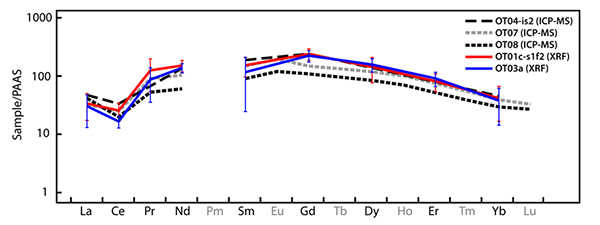A study led on the DIFFABS and LUCIA beamlines by scientists from the Research Platform on Ancient Materials IPANEMA (CNRS, MCC) and from the SOLEIL synchrotron facility reported a micrometric mapping of cerium concentration and speciation on several fossils. Those results, published in the review Analytical Chemistry, give insights on past geological or climatic conditions on Earth.
Estimations of rare earth elements (REE) concentrations are known to be an interesting proxy, able to provide information on paleo-environmental and paleo-geographical conditions of a specific site at a given time. By establishing models of the concentrations evolution of those elements, scientists dispose of information allowing assessing the environment’s properties. Among rare earth elements, cerium is a particular case. On average, on the earth’s crust, cerium is as abundant as transition metals such as copper, nickel or zinc. Whilst other REEs are mainly trivalent, Ce can be present under the +III and +IV oxidation states. The Ce(IV) formed under oxidizing conditions being insoluble, this specificity induces distinct transport, fractionation and reactivity properties of cerium compared to other rare earth elements, thus forming “the cerium anomaly”.
The use of this anomaly as an environmental proxy relies on a supposed homogeneity of the cerium oxidation state within the sample. However, it has never been demonstrated. The IPANEMA team succeeds to bring this evidence for three different fossils, using a combination of microbeam X-ray fluorescence and X-ray absorption spectroscopy.
The study focused on this cerium anomaly at the micrometric scale. Three fossils belonging to the Muséum d’Histoire Naturelle de Marrakech and dated from the Late Cretaceous (100 Myr) were analyzed. Microbeam X-ray fluorescence measurements on the DIFFABS beamline were performed in order to map the REE concentrations. Those results, compared to ICPMS elemental quantifications, reveal the presence of a negative cerium anomaly within all samples.

Partial semiquantitative REE patterns reconstructed from the processed XRF spectra compared to REE patterns based on ICPMS quantifications. OT01c-s1f2 and OT03a, partial semiquantitative PAAS-normalized REE patterns reconstructed from the XRF data (16 pixels areas), respectively, collected in the peculiar, notched, elongated bone from the teleost fish OT03a and in the soft tissues of the shrimp C. berberus (crosssection OT01c-s1f2); OT04-is2, partial PAAS-normalized REE pattern based on ICPMS quantifications from data collected in a submillimeter sample from a teleost fish (tissue sample OT04-is2); OT07 and OT08, complete PAAS-normalized REE patterns based on ICPMS quantifications from data collected in submillimeter samples, respectively, from another specimen of the shrimp C. berberus (soft tissue sample OT07) and from a sample of an isolated rostral tooth from the chondrichthyan Onchopristis (OT08) that was found in the sandstone layer just below the clayey beds that delivered the other fossils; elements in gray could not be measured in the partial patterns.
Additional measurements recorded at the submillimeter scale, still on DIFFABS using XANES spectroscopy at the cerium L3 edge clearly identified both +III and +IV oxidation states. Analyses also have been performed at the micrometric scale on the LUCIA beamline. For the three studied fossils, 20% (+/-5%) of the cerium is present at the +IV oxidation state, and in a homogeneous way between different organs (bones versus mineralized muscles). Although the global quantity of cerium varies, the [Ce(IV))/[Ce(tot)] ratio seems to remain stable. Since the samples come from different fossiliferous layers of the site, such results tend to demonstrate that the overall local redox conditions can also be considered as homogeneous at the scale of several successive stratigraphic layers.
Such methodological developments improve our knowledge regarding the behavior of cerium within fossils, allowing a more precise reconstitution of paleo-environments and fossilization mechanisms. These results demonstrate that the synchrotron radiation, through the combination of non-destructives complementary techniques, constitutes a promising tool to study chemical speciation in fossils at microscale. It now remains to be shown whether the Ce(IV) proportion corresponds to an early, integrated or final state of the local conditions of burial. This methodology clearly deserves to be applied to other paleo-environmental and geo-environmental proxies.
